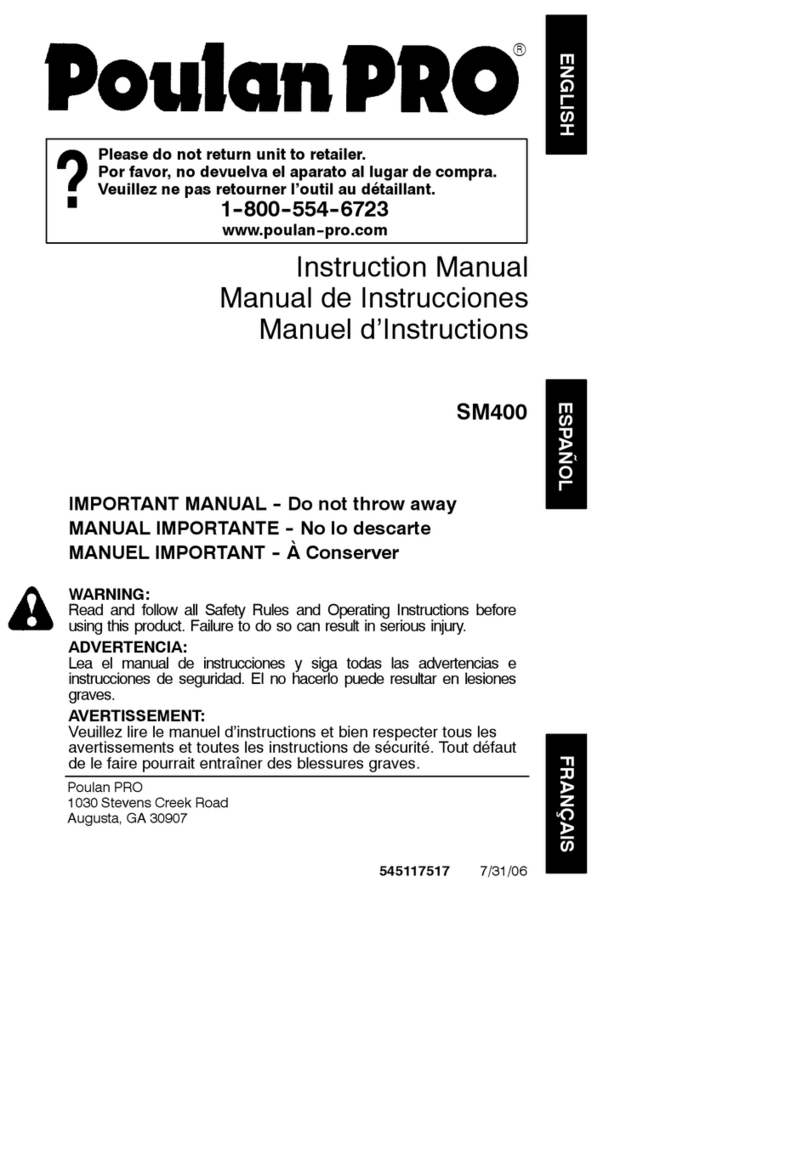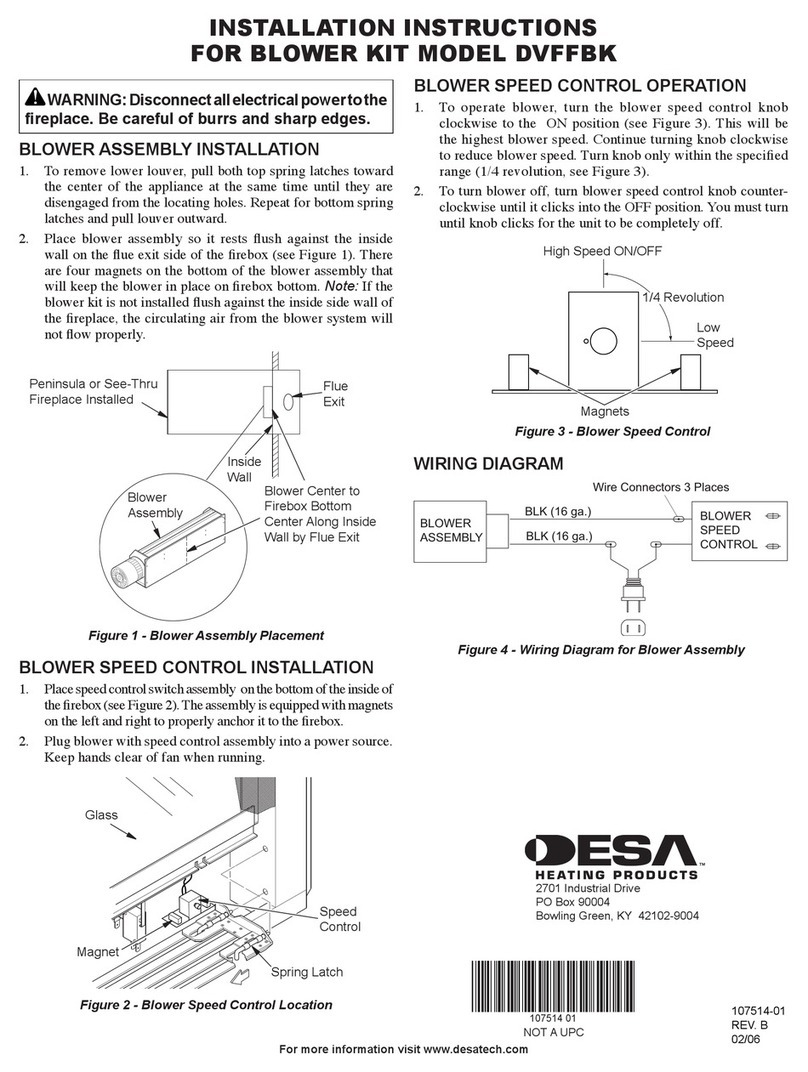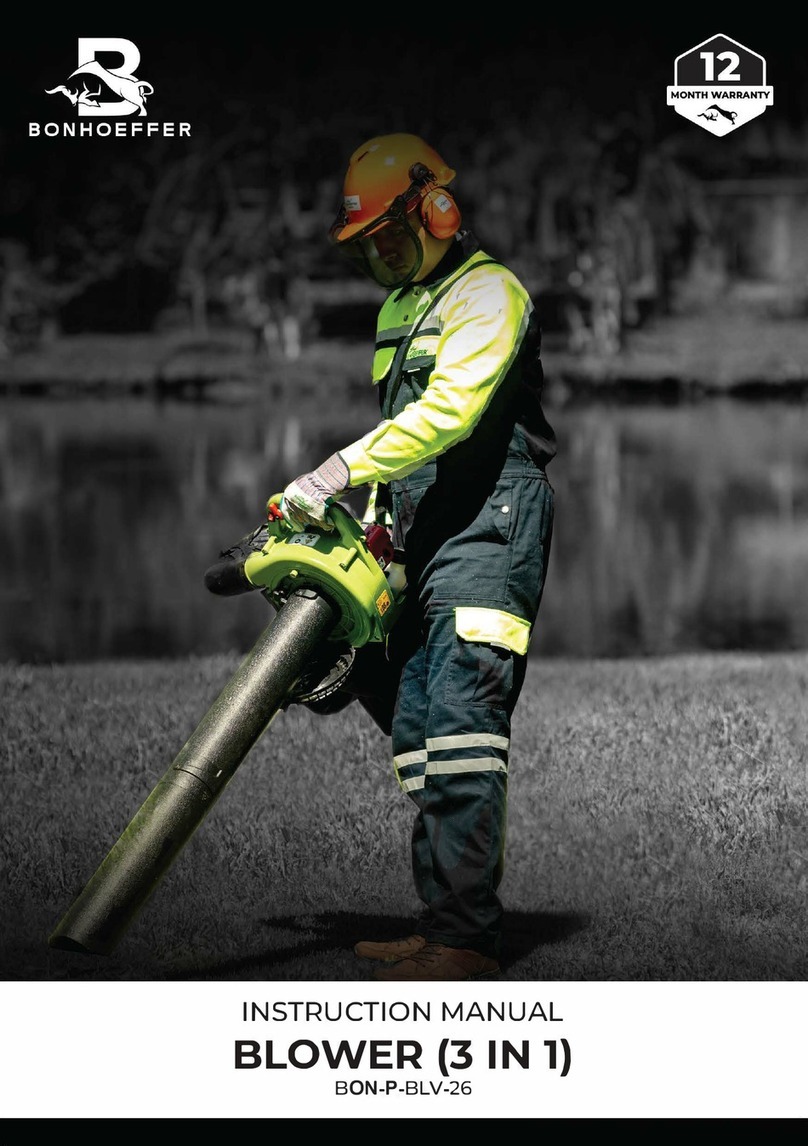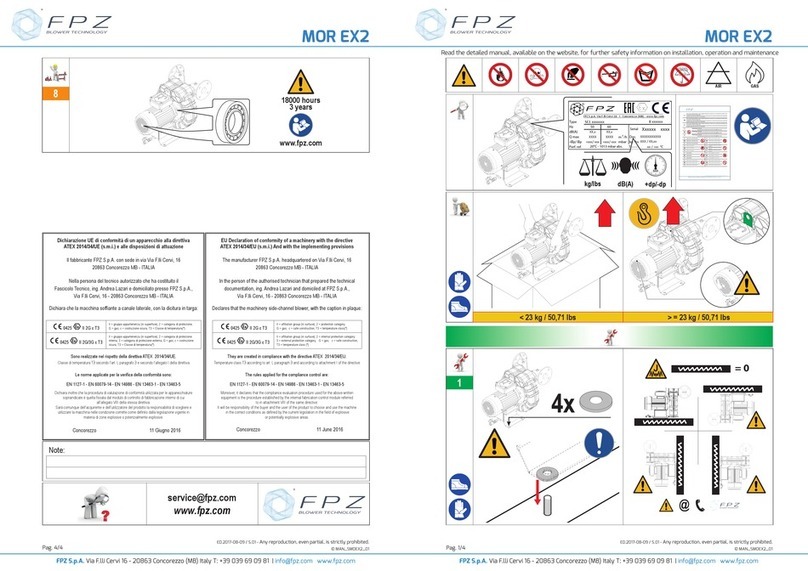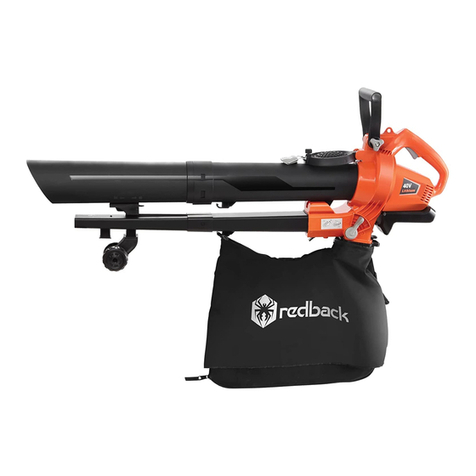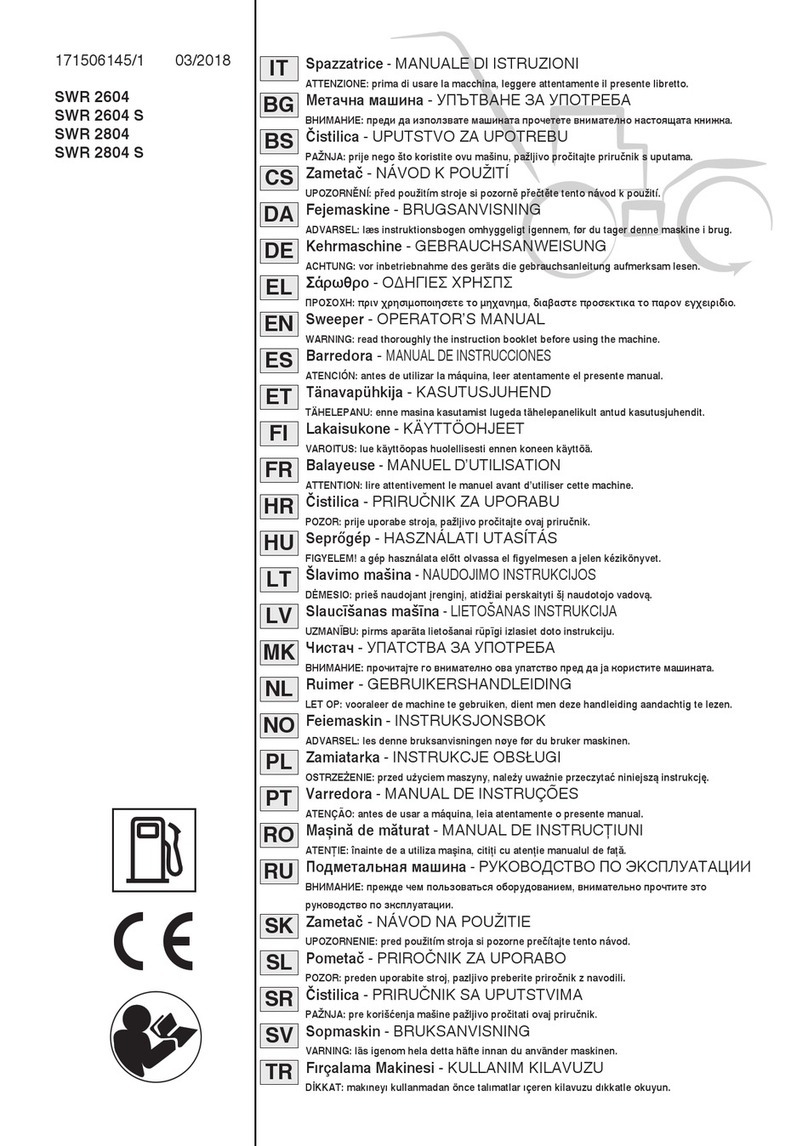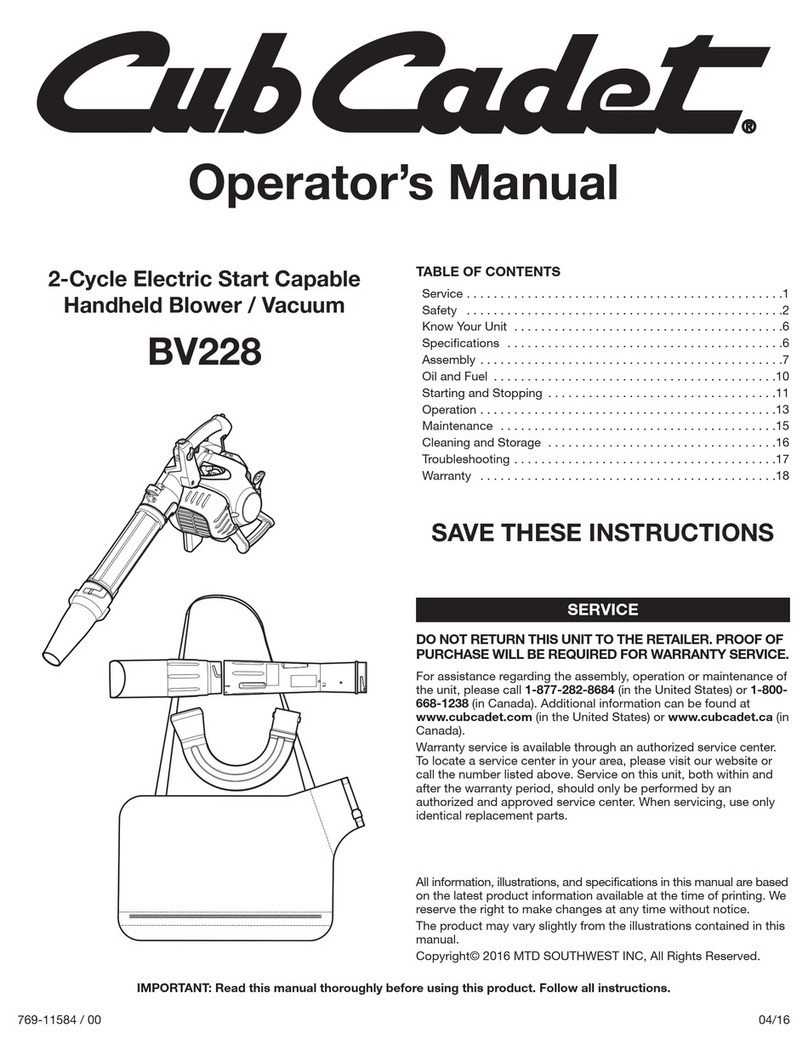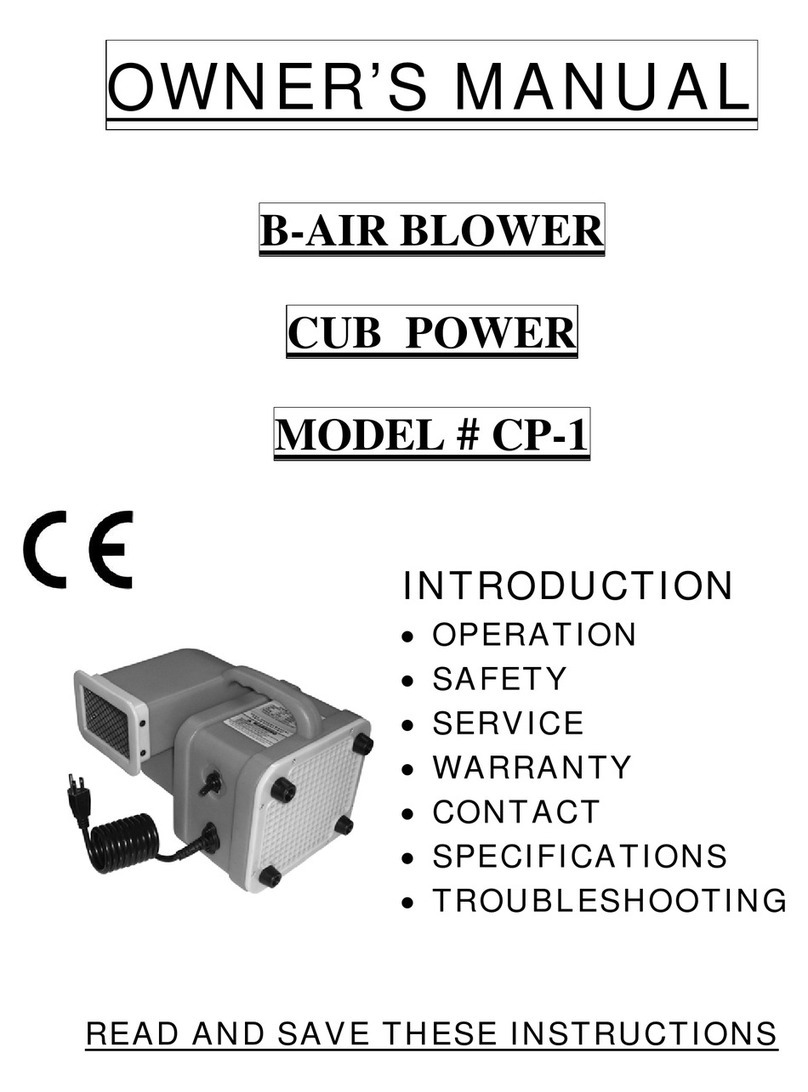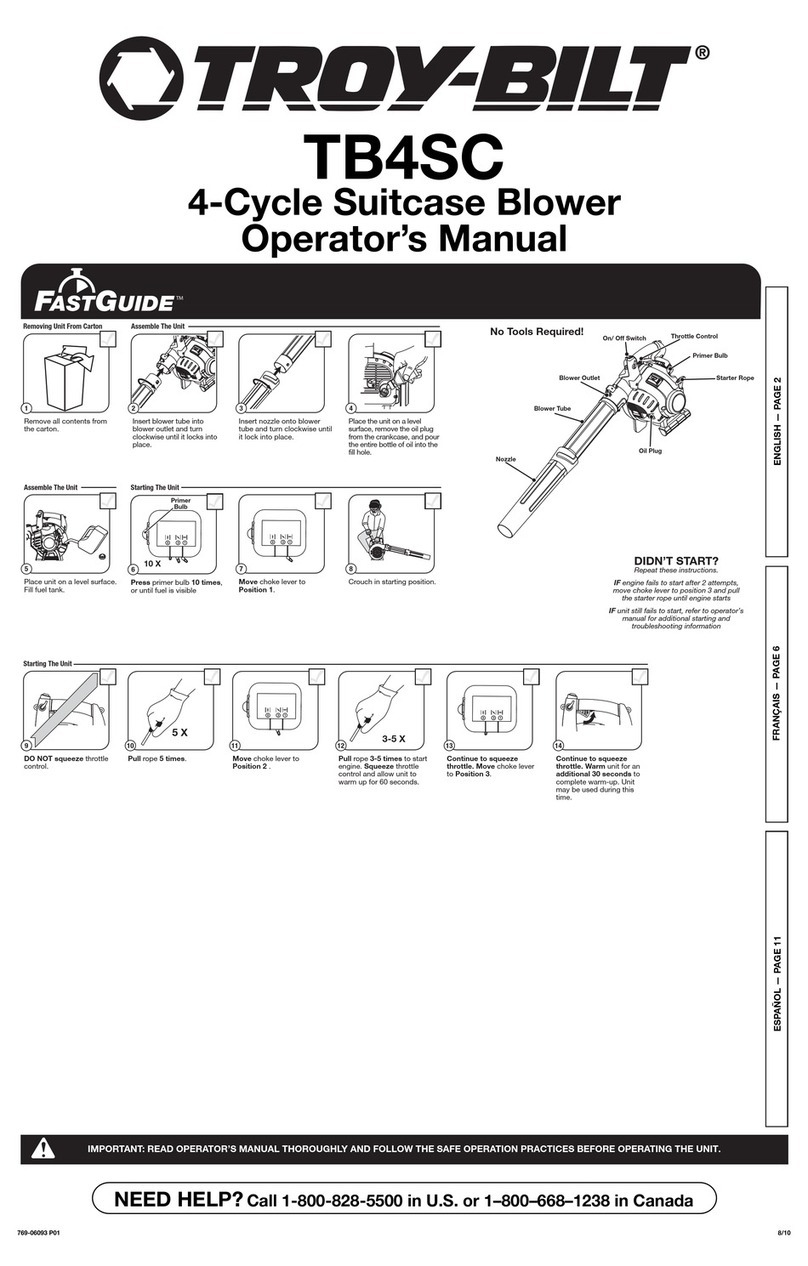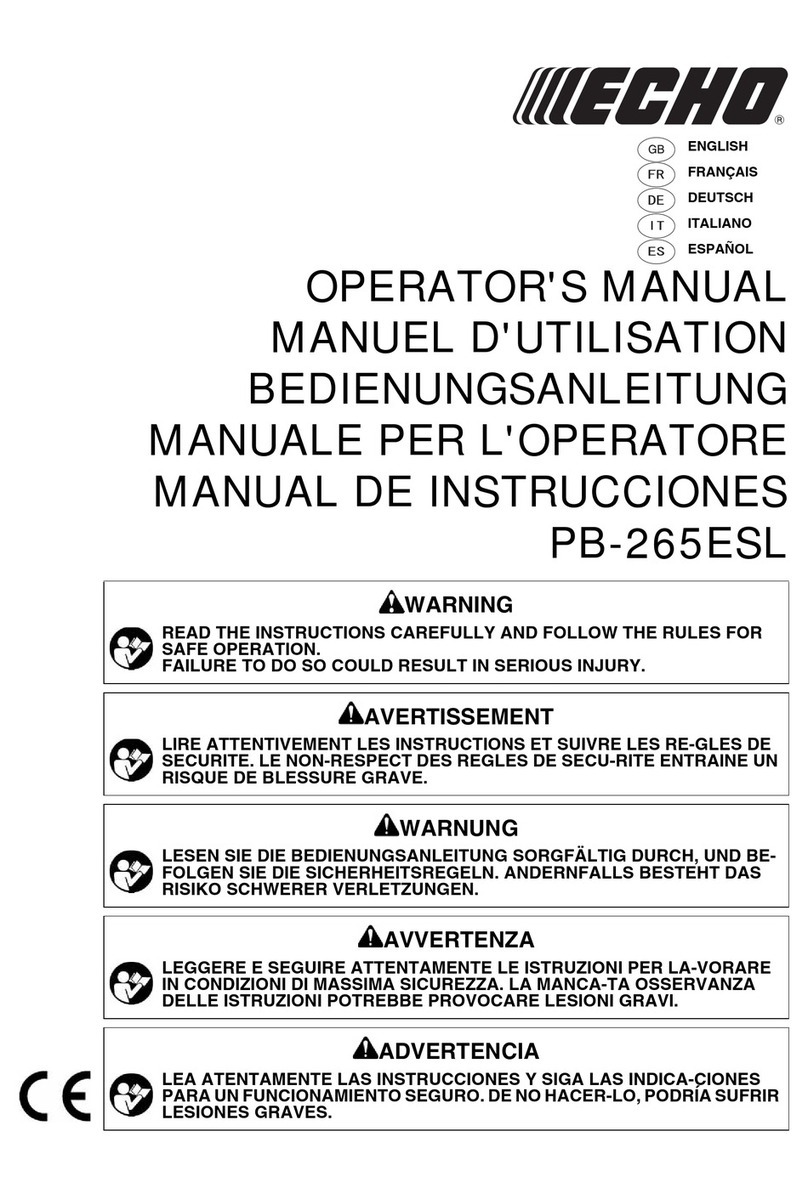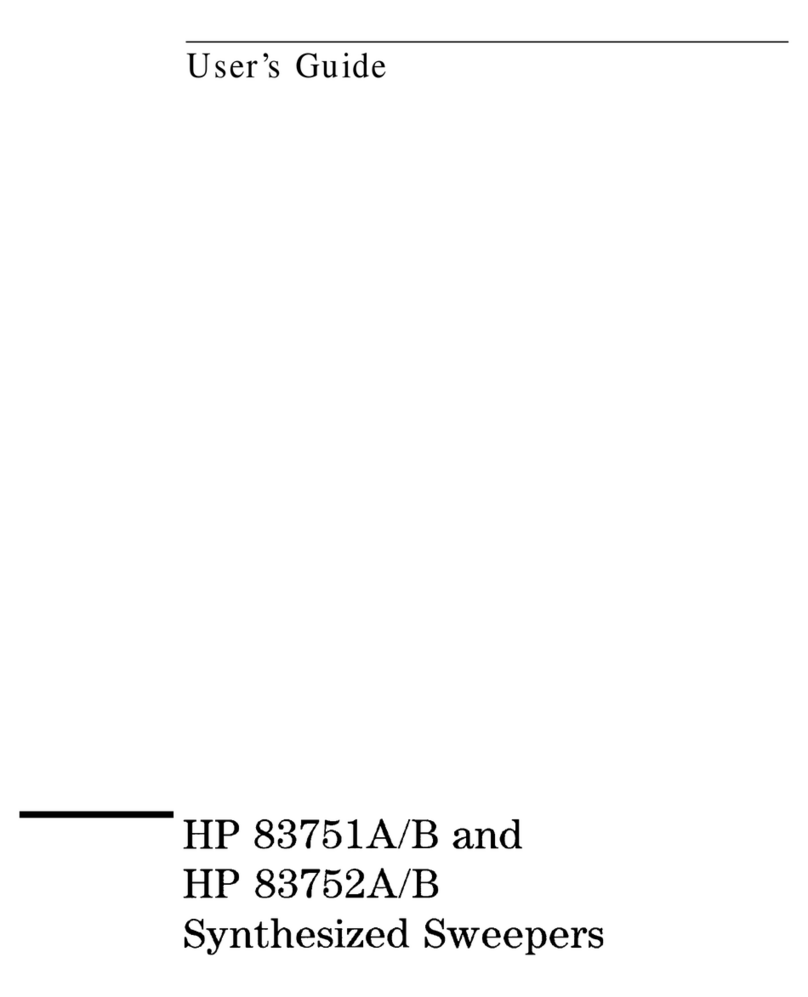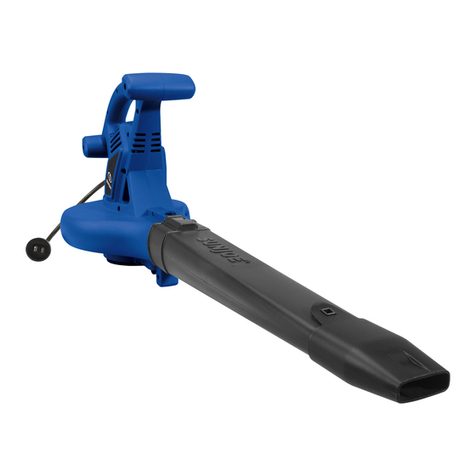MFM BPX735 User manual

Petrol Powered Back-Pack Blower
User Manual
[Revision 2.0 October 2016]
RETAIN THIS MANUAL FOR FUTURE REFERENCE
PLEASE READ THIS MANUAL CAREFULLY BEFORE USE

Petrol Powered Back Pack Blower
i
Table of Contents
Safety.................................................................................................................................................................1
Included Items and Parts Identification ...........................................................................................................3
Set-Up ................................................................................................................................................................4
Operation...........................................................................................................................................................7
Starting and Stopping the Engine..................................................................................................................7
Breaking-In....................................................................................................................................................8
During Operation...........................................................................................................................................8
After Finishing Work......................................................................................................................................8
Maintenance and Storage.................................................................................................................................8
Cleaning the Air Filter....................................................................................................................................8
Carburettor....................................................................................................................................................9
Checking the Spark Plug...............................................................................................................................9
Engine Running Behaviour............................................................................................................................9
Storing the Machine ......................................................................................................................................9
Minimum Wear and Avoiding Damage.........................................................................................................10
Repairs .......................................................................................................................................................10
Specifications..................................................................................................................................................10

Petrol Powered Back Pack Blower
1
Safety
•Special safety precautions must be observed when working with the power tool.
•It is important that you read, fully understand and observe the following safety precautions and
warnings.
•Careless or improper use of any blower may cause serious or fatal injury.
−Observe all applicable local safety regulations standards and ordinances.
•Minors should never be allowed to use a blower.
−Bystanders, especially children, and animals should not be allowed in the area where a blower is in use.
−The operator has the responsibility to avoid injury to third parties and damage to their property.
−Do not lend or rent your blower without this user manual. Be sure that anyone using the blower
understands the instructions contained in this manual.
•You must be fit to work with a blower.
−You must be well-rested and in good physical and mental condition.
−If you get tired, take a short break.
−Do not operate the blower if you are under the influence of any substances (drugs, alcohol, etc.) which
might impair your vision, dexterity or judgment.
•Only accessories that are supplied by the manufacturer are approved for use with the blower..
−Other accessories must not be used because of the increased risk of accidents.
−Exclude all liability for personal injury and damage to property caused while using unauthorised
accessories.
•Wear proper clothing and equipment.
−Clothing must be sturdy and snug-fitting, but allow complete freedom of movement - safety clothing is
recommended.
−Avoid loose-fitting jackets, scarves, neckties, jewellery, flared or cuffed pants, unconfined long hair or
anything that could get into the air intake.
−Wear sturdy boots with nonslip soles. Steel-toed safety boots am recommended.
•Wear safety glasses, goggles or a face shield.
−Wear sound barriers (ear plugs or mufflers) to protect your hearing.
−Wear heavy-duty, nonslip gloves, preferably made of leather.
•Always stop the engine before refuelling.
•Fuel is extremely flammable. Do not smoke or ignite a fire near fuel.
−Do not add fuel to a hot engine – fuel may spill and could cause a fire.
−Remove the fuel filler cap on the unit carefully so as to allow any pressure build-up in the tank to be
released slowly.
−Fuel your blower in well-ventilated, outdoor areas only. Wipe off any spilled fuel before starting and
check for any leakages.
−Take care not to get fuel on your clothing. If this happens, change immediately.

Petrol Powered Back Pack Blower
2
•Unit vibrations can cause an improperly tightened fuel cap to loosen or come off and spill fuel.
−In order to reduce the risk of fuel spillage and fire, tighten the fuel cap.
−On units with a screw cap: tighten the cap firmly by hand.
−On units with a hinged handle on the fuel cap: tighten as described in the “Fuelling” section.
•Check for any fuel leakage while refuelling and during operation. If fuel leakage is found, do not start
or run the engine until the leakage has been fixed.
•Store fuel and oil in properly labelled, approved safety-type cans.
•Always stop the engine when you are transporting the blower.
•When transferring the blower in a vehicle, protect it properly to prevent turnovers, fuel spillages and
potential damages. When the unit is not in use, put it down so that it does not endanger others.
•Before starting, check the following:
−Throttle trigger must move freely and spring back to idle position when released.
−Stop switch must move easily to "OFF".
−Tighten the spark plug cap if it is loose. Sparks may occur and ignite the escaping fuel vapours.
•Starting
−Start the engine at least 3m from the fuelling spot, outdoors only.
−To reduce the risk of breathing toxic fumes, never start or run your unit in confined spaces.
−Place the unit on firm ground in an open area.
−Make sure you have good balance and secure footing.
−Hold the unit securely.
−Do not allow other persons to be near the running unit, even when starting.
•During operation
−Warning! Your blower produces toxic exhaust fumes when the engine is running. These gases (e.g.
carbon monoxide) may be colourless and odourless. To reduce the risk of serious or fatal injury from
breathing toxic fumes, never run the blower indoors or in poorly ventilated locations.
−Ensure proper ventilation when working in trenches, hollows or other confined areas.
−To reduce the risk of igniting the combustible fuel vapour and causing a fire, never smoke while working
with or standing next to the blower.
−Always hold your unit firmly – make sure you always have a firm and secure footing.
−Examine the work area: Do not direct the air blast towards bystanders since the air flow can blow small
objects at great speed.
•Be cautious in slippery conditions.
−On ice, snow or wet/damp environments.
−On slopes or uneven ground.
•Watch out for obstacles.
−Roots, ditches, holes or rubbish, which could cause you to trip or stumble.

Petrol Powered Back Pack Blower
3
•Warning! When blowing:
−To reduce the risk of inhaling poisonous fumes from chemicals and exhaust gases, do not operate the
blower in confined spaces.
−Walk forward only when the unit is running.
−In an emergency, release the quick-action buckles, slip out of the harness and throw off the machine.
−After finishing work, drain the fuel tank.
Included Items and Parts Identification
Note: Some assembly is required.

Petrol Powered Back Pack Blower
4
Set-Up
Step 1: Attach the flexi tube
1. Place the flexi tube over the backpack air outlet. Tighten clamp ring with the multi-tool (or a 7mm hex
socket).
Choke
Air filter
Priming bulb
Carry handle
Spark plug
Throttle
Fuel tank
Exhaust
Starter handle
Fuel cap
Engine ON/OFF
Switch

Petrol Powered Back Pack Blower
5
Step 2: Attach the tubes
1. The tubes are connected in this order.
2. Tighten handle, ensuring it's in a suitable and
comfortable position when in use.

Petrol Powered Back Pack Blower
6
3. Fit the nozzle into the extension tube.
4. Insert the nozzle into the tip (if desired).
Once the engine is started, “wear” the blower as
shown.

Petrol Powered Back Pack Blower
8
Breaking-In
A new machine should not be immediately run at high engine speeds, as the internal components need to “bed-
in”. It is recommended to allow the engine to fully warm up before beginning to increase engine speed. For the
first hour of engine use, avoid rapid changes in engine speed. The engine develops maximum power after about
5 to 15 tank fillings.
During Operation
After a long period of full-throttle operation, allow the engine to run for a while at idle speed so that the heat can
be dissipated by a flow of cooling air. This protects the engine-mounted components (ignition, carburettor, etc.)
from thermal overload.
After Finishing Work
Release the throttle and place the engine ON/OFF switch in the “OFF” position, then wait for the engine to cool
down. Leave some fuel in the tank and store the unit upright in a dry place out of the reach of children or
unauthorised persons. For storing for long periods of time, see the "Storing the Machine” section.
Maintenance and Storage
•Do not attempt any maintenance or repair work not described in this user’s manual. Have such work
performed at your service shop only.
•Never modify your power tool in any way as this could result in serious injury.
•Always stop the engine and disconnect the spark plug cap before doing any maintenance/repair work or
cleaning the machine (exception: carburettor and idle adjustments).
•Always clean dust and dirt off the machine after finishing work.
•Do not store or service your unit near any fire or flame.
•Check the fuel cap regularly for any signs of leakages.
•Use only the approved spark plug and make sure it is in good condition.
•Inspect the ignition wires (insulation in good condition, secure connection).
•To reduce the risk of fire due to ignition outside of the cylinder, move the stop switch to “OFF” before turning
the engine over on the starter with the spark plug cap removed or the spark plug unscrewed.
•Check the condition of the exhaust periodically.
•To avoid the risk of fire or hearing loss, do not operate your unit if the muffler is damaged or missing.
•Never touch a hot muffler or serious burns will result.
Cleaning the Air Filter
Dirty air filters reduce engine power, increase fuel
consumption and make starting more difficult.
If there is a noticeable loss of engine power:
•Close the choke.
•Pull A and remove the air filter cover.
•Remove the filter from the cover and inspect it. If it is dirty

Petrol Powered Back Pack Blower
9
or damaged, clean the filter with warm water and mild detergent and allow to dry, or fit a new one. Place a
few drops of oil on the air filter element and squeeze it a few times to distribute the oil.
•Install the filter element and re-install the air filter cover.
Carburettor
Your carburettor comes factory set for optimum fuel-air mixture under most operating conditions.
The high speed screw alters the engine power output and the maximum unloaded engine speed. If the setting is
too lean, there is a risk of engine damage due to insufficient lubrication and overheating.
Checking the Spark Plug
If engine is down on power, difficult to start or runs poorly at idle
speed, first check the spark plug.
•Remove the spark plug using the supplied spanner and
clean off any carbon build-up with a wire brush.
•Check the electrode gap (A) (0.6 – 0.7mm) and adjust if
necessary.
•Rectify any problems which may be affecting the spark plug:
−Too much oil in fuel mixture (oily electrodes).
−Dirty air filter.
Fit a new spark plug after about 100
operating hours, or sooner if the electrodes
are badly eroded.
•If the spark plug comes with a
detachable connector, firmly tighten it.
•Press the cap firmly onto the spark plug.
Engine Running Behaviour
If engine running behaviour is unsatisfactory even though the air filter is clean and the carburettor properly
adjusted, the cause may be in the muffler. Have the muffler checked for carbon build-up by the manufacturer or
an authorised service centre.
Storing the Machine
For periods of 3 months or longer:
•Drain the fuel tank.
•Run the engine until carburettor is dry. This helps prevent the carburettor diaphragms from sticking together.
•Thoroughly clean the machine. Pay special attention to the cylinder and air filter.
•Remove the spark plug and pour approximately 20ml of engine oil into the cylinder. Slowly pull the start cord
several times, then re-install the spark plug.
•Store the machine in a dry, secure location out of the reach of children and unauthorised persons.

Petrol Powered Back Pack Blower
10
•Do not expose the container to direct sunlight for an unnecessarily long period. UV light can make the
container material brittle, which could result in leaks or breakage.
Minimum Wear and Avoiding Damage
Observing the instructions in this manual helps reduce the risk of unnecessary wear and damage to the power
tool. The power tool must be operated, maintained and stored with the due care and attention described in this
user’s manual.
The user is responsible for all damage caused by non-observance of the safety precautions, operating and
maintenance instructions in this manual. This includes in particular:
•Alteration or modifications to the product not approved by the manufacturer.
•Using accessories, power tool accessories or cutting tools not approved by the manufacturer.
•Using the product for purpose for which it was not designed.
•Using the products for sports or competitive events.
•Continuing to use the product with defective components.
Repairs
All the operations described as maintenance must be performed on a regular basis. If these operations cannot
be performed by the owner, they should be performed by an authorised dealer. If these operations are not
carried out as specified, the user assumes responsibility for any damage that may occur. Among other things,
this includes:
•Damage to the engine due to neglect or deficient maintenance, incorrect carburettor adjustment or
inadequate cleaning of cooling air inlets.
•Corrosion and other consequential damages resulting from improper storage.
Specifications
Model BPX735
Engine Type Petrol EURO 2 -2 Stroke Commercial
Displacement 65cc
Engine Speed 7,500 RPM
Ignition Type Recoil Start
Air Velocity 490km/h
Air Volume 0.32m3/s
Fuel Tank Capacity 1.8L
Fuel Type Non-ethanol unleaded
Fuel Mix 25:1 (25 parts fuel to 1 part 2-stroke oil)

Petrol Powered Back Pack Blower
11
Some experts believe the incorrect or prolonged use of almost any product could
cause serious injury or death. For information that may reduce your risk of serious
injury or death, consult the points below and additionally, the information available at
www.datastreamserver.com/safety
•Consult all documentation, packaging and product
labelling before use. Note that some products feature
online documentation which should be printed and kept
with the product.
•Check product for loose / broken / damaged / missing
parts, wear or leaks (if applicable) before each use.
Never use a product with loose / broken / damaged /
missing parts, wear or leaks (if applicable).
•Products must be inspected and serviced (if applicable)
by a qualified specialist every 6 months assuming
average residential use by a person of average weight
and strength, above average technical aptitude, on a
property matching average metropolitan specification.
Intended use outside these guidelines could indicate the
product is not suitable for intended use or may require
more regular inspection or servicing.
•Ensure all possible users of the product have completed
an industry recognized training course before being
given access to the product.
•The product has been supplied by a general merchandise retailer that
may not be familiar with your specific application or your description of
the application. Be sure to attain third-party approval for your
application from a qualified specialist before use regardless of prior
assurances by the retailer or its representatives.
•This product is not intended for use where fail-safe operation is
required. As with any product (take an automobile, aircraft, computer
or ball point pen for example), there is always a small chance of
technical issues that needs to be repaired or may require replacement
of the product or a part. If the possibility of such failure and the
associated time it takes to rectify could in any situation inconvenience
the user, business or employee then the product is not suitable for
your requirements. This product is not for use where incorrect
operation or a failure of any kind, including but not limited to a
condition requiring product return, replacement, service by a technician
or replacement of parts could cause a financial loss, loss of employee
time or an inconvenience requiring compensation.
•If this item has been purchased in error after considering the points
above, simply contact the retailer directly for details of their returns
policy, if required.
Table of contents
Other MFM Blower manuals




